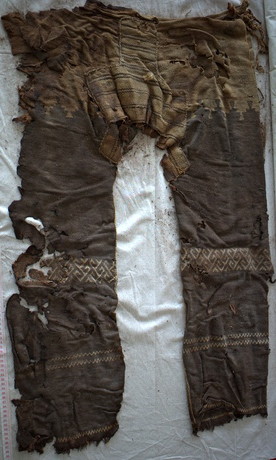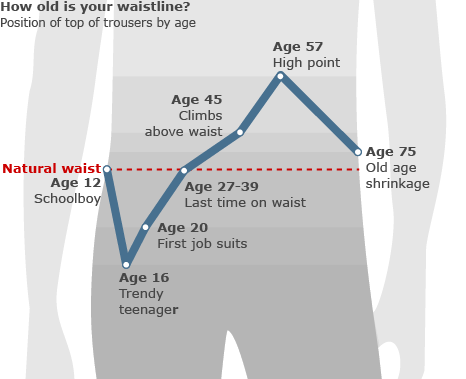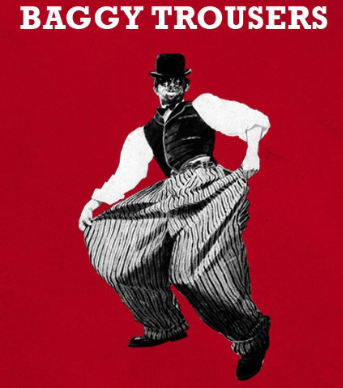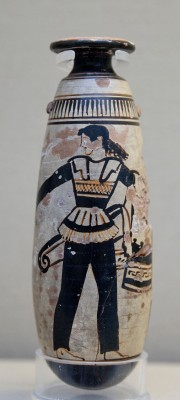The Friday Fillip: Pants
Pants: Rubbish; nonsense. Freq. in pile (also load) of pants. (Brit. slang)
Which is one reason why I’m going to talk about trousers instead. (Another reason, also grounded in respect for our British readers, is that in that green and pleasant land “pants” refers to undergarments and can cause fourth form giggling.)
What piece of clothing could be more humble than a pair of men’s trousers?
Socks, perhaps. Though, socks have the potential to be colourful and to display strange and wonderful designs, something that trousers continue to resist, the recent craze for red jeans notwithstanding. Yet this ubiquitous, typically undistinguished bottom-half covering has a chequered history and a more complex present than you might imagine.
We could start some 3,300 years ago with what have been heralded  as the oldest surviving pair of trousers — but such a long detailed history would be too large a load of pants for a mere fillip. Even so, if you didn’t catch the news item from a couple of weeks ago about these Chinese duds, seen at the left, you might want to take a look at the item when you have a moment; given the trousers’ resemblance to some cargo pants I’ve known, it’s a plus ça change story, I think, which is reassuring in its way.
as the oldest surviving pair of trousers — but such a long detailed history would be too large a load of pants for a mere fillip. Even so, if you didn’t catch the news item from a couple of weeks ago about these Chinese duds, seen at the left, you might want to take a look at the item when you have a moment; given the trousers’ resemblance to some cargo pants I’ve known, it’s a plus ça change story, I think, which is reassuring in its way.
It took a while, though, for the notion of trousers to catch on in the West, particularly among the movers and shakers. Until relatively recently trousers belonged to the outsiders — those who were foreign (and wore pantaloons), or who worked rough jobs or who couldn’t afford the coverings that were fashionable. The common covering for men’s lower halves was breeches (or “breeks” or “britches”), in effect trousers that terminated just below the knee, where they met long socks. Eventually, however, the looser, longer garment found favour somewhere around 150 to 200 years ago. (Some credit Beau Brummel with the invention of the modern trousers.) And with it, came certain . . . problems of both stylistic and practical natures.
Tops and bottoms
At the top was the pressing problem of keeping trousers up. By and large men have favoured ties at the waist — belts or ropes to cinch things in — and have only occasionally adopted the superior method of using braces, as the English call them, or suspenders as they’re known here, which hang the pair of trousers on straps from the wearer’s shoulders. I say “superior” for a couple of reasons, one of which is demonstrated by a brief account in an Icelandic saga. In the Bard’s saga “It is told that Einar Sigmundarson called on the Bard to fight. However, when Einar Sigmundarson’s belt broke [and he clutched at his falling trousers], Lón-Einars took advantage and smote Einar until he died.”*
 The other practical reasons for liking braces/suspenders has to do with the frequent male difficulty of finding a waist to cinch things to. Here practicality and style show their antagonism, for despite the inaptness of many men’s anatomy to belting, style has moved the “waist” around over the years quite considerably, often to perfectly impractical places. The chart to the right, taken from a BBC article on the problem, shows the nature of the wandering waist, forcing belt-men to reveal their age through the height of their trousers, given not simply the landscape of their changing anatomies but also that of fashion. Now, trousers “should” be hitched somewhere just below the “natural” waist; whereas, to pick an example at the other extreme, zoot suits of the 30s and 40s hoisted trouser tops to just below the breast.
The other practical reasons for liking braces/suspenders has to do with the frequent male difficulty of finding a waist to cinch things to. Here practicality and style show their antagonism, for despite the inaptness of many men’s anatomy to belting, style has moved the “waist” around over the years quite considerably, often to perfectly impractical places. The chart to the right, taken from a BBC article on the problem, shows the nature of the wandering waist, forcing belt-men to reveal their age through the height of their trousers, given not simply the landscape of their changing anatomies but also that of fashion. Now, trousers “should” be hitched somewhere just below the “natural” waist; whereas, to pick an example at the other extreme, zoot suits of the 30s and 40s hoisted trouser tops to just below the breast.
And there’s difficulty at the other end, this time thanks to fashion alone: should trousers, particularly suit trousers, have cuffs or not? This is a matter of such import that the Wall Street Journal has addressed the issue, acknowledging that:
It’s a fine line. Some might argue that men sporting traditional cuffs like those Mr. Young described run the risk of veering into “dad” territory. The look on the spring runways avoided that pitfall with trim, tapered silhouettes and hems that stopped jauntily near the ankle—instead of hitting the top of the shoe as most sartorial conservatives would advise.
They finished the piece, however, this way:
“Cuffs on trousers are like teats on a bull—unnecessary, unbecoming,” said Duncan Quinn, a British ex-pat who owns bespoke shops in New York and Los Angeles. “A good trouser is cut to sit properly on a shoe. Precise, clean, sharp. Just like the Queen’s guards.”
Men and women
Of course, women wear trousers, too, though once that was considered improper for all sorts of reasons, reasons that turned out to be just as specious as any of the those that guard the current boundaries between and among genders. Indeed, one of those guardians — a Parisian by-law prohibiting women from dressing like men, including by wearing trousers, was finally taken off the books only a year ago. And I’m not sure the legal profession has a lot to cheer about on this score: a contributor to the UK’s Barrister Magazine can write ” . . . In that time [20 years] it is certainly fair to say that the battle lines have shifted – women can now wear trousers in court (hoorah) . . . ” And I have a suspicion, but do not know, that it’s only recently that some law firms have abandoned the (likely unwritten) rule that women lawyers should not wear trousers to the office.
In a recent attempt to combat sexism, some lycées in Nantes adopted a day on which boys would wear skirts instead of trousers — affirming how powerful the bottom-half garment is in constructing or defining gender, kilts and sarongs notwithstanding. Now, if bending, not breaking the rules, is enough for you, perhaps the ska band Madness is the way to finish, with their song Baggy Trousers.




Comments are closed.